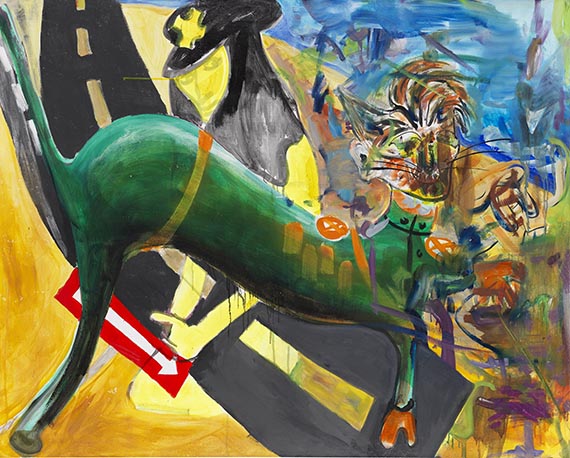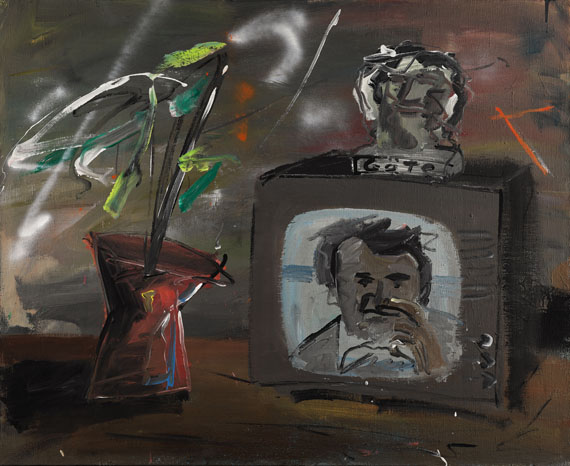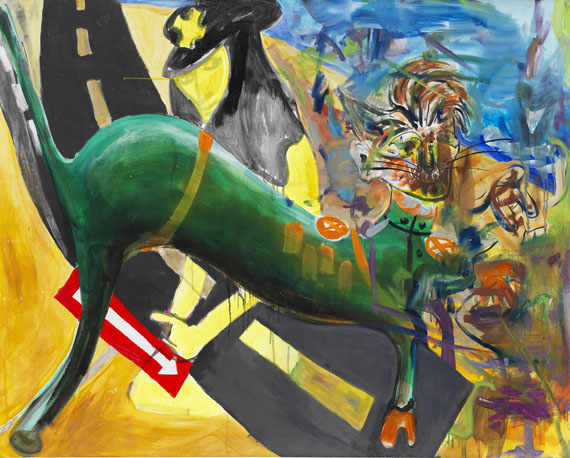324
Albert Oehlen
mit André Butzer (1973 Stuttgart) und Schorsch Kamerun (d. i. Thomas Sehl, 1963 Timmendorfer Strand). Walker, 1999.
Oil on canvas
Estimation: € 80,000 / $ 88,000
mit André Butzer (1973 Stuttgart) und Schorsch Kamerun (d. i. Thomas Sehl, 1963 Timmendorfer Strand). Walker. 1999.
Oil on canvas.
Signed, dated and titled by all three artists on the reverse of the canvas. 120 x 150 cm (47.2 x 59 in).
[AR].
• Typical joint work for Albert Oehlen, in this case with André Butzer and Schorsch Kamerun.
• Comparable collaborations with artist friends are a special feature of Albert Oehlen's work.
• He is considered one of the protagonists of German New Expressionism.
• First exhibited on the occasion of the “Steirischer Herbst” at Galerie Bleich-Rossi in Graz the year it was made.
PROVENANCE: Galerie Bleich-Rossi, Graz.
Private collection, Steiermark.
Private collection, Hesse.
EXHIBITION: New Stream. Albert Oehlen, André Butzer, George Kamerun, Galerie Bleich Rossi, Graz, September 25 - October 24, 1999.
"The pictures, whether good or bad, pretty or ugly, assert themselves without any excuses. No magic, no science, no explanations.."
Albert Oehlen, ohne Jahr, quoted from: Kritisches Lexikon der Gegenwartskunst, Albert Oehlen, volume 29, Munich 1995, p. 14.
Called up: December 7, 2024 - ca. 16.17 h +/- 20 min.
Oil on canvas.
Signed, dated and titled by all three artists on the reverse of the canvas. 120 x 150 cm (47.2 x 59 in).
[AR].
• Typical joint work for Albert Oehlen, in this case with André Butzer and Schorsch Kamerun.
• Comparable collaborations with artist friends are a special feature of Albert Oehlen's work.
• He is considered one of the protagonists of German New Expressionism.
• First exhibited on the occasion of the “Steirischer Herbst” at Galerie Bleich-Rossi in Graz the year it was made.
PROVENANCE: Galerie Bleich-Rossi, Graz.
Private collection, Steiermark.
Private collection, Hesse.
EXHIBITION: New Stream. Albert Oehlen, André Butzer, George Kamerun, Galerie Bleich Rossi, Graz, September 25 - October 24, 1999.
"The pictures, whether good or bad, pretty or ugly, assert themselves without any excuses. No magic, no science, no explanations.."
Albert Oehlen, ohne Jahr, quoted from: Kritisches Lexikon der Gegenwartskunst, Albert Oehlen, volume 29, Munich 1995, p. 14.
Called up: December 7, 2024 - ca. 16.17 h +/- 20 min.
The joint work, “Walker” by Albert Oehlen, André Butzer, and Schorsch Kamerun, was first shown in the context of the “Steirischer Herbst” art festival at Galerie Bleich-Rossi in 1999. All three artists participated several times in this Austrian contemporary art festival, which is still considered a pioneering event today. It took place for the first time in the seminal year of 1968 and has placed focus on interdisciplinary exchange ever since.
In the present large work by the three German artists, a bright green, sphinx-like creature leaps through the picture, its New Wave head sporting a wild mane. Epaulettes suggest a cool uniform jacket. A road leads into the distance behind it, and a stage diva reminiscent of the YMCA policeman is kneeling. This work raises questions concerning otherness. This topic is very much in line with the festival of that time and the associated “question of how to deal with the other and the appropriation and exclusion of the minoritarian, the emergence of hybrid identities and the disturbances of the body, the reflection on the work of art as a product of the division of and the conditions of its production,” as the former artistic director Christine Frisinghelli put it (https://archiv.steirischerherbst.at/de/editions/1999, accessed October 18, 2024).
Oehlen, Butzer, and Kamerun all grew up during the punk era and new wave; the “Neue Wilden” (New Wild Ones) coincided with the renewal of figurative art in the Federal Republic of Germany. Here, the three artists reflect on a past that they have personally experienced. While Butzer and Oehlen are primarily known as visual artists, Schorsch Kamerun is best known as the singer of the punk band “Die goldenen Zitronen” and today also works as a director at major theaters such as the Zurich Schauspielhaus and the Munich Kammerspiele. Albert Oehlen is not only considered one of the leading representatives of “post-non-representational painting” but also one of those European artists who, as early as in the early 1980s, were willing to paint pictures that are still considered the basis for everything regarded “worthwhile seeing” in the early 21st century. [EH/AR]
In the present large work by the three German artists, a bright green, sphinx-like creature leaps through the picture, its New Wave head sporting a wild mane. Epaulettes suggest a cool uniform jacket. A road leads into the distance behind it, and a stage diva reminiscent of the YMCA policeman is kneeling. This work raises questions concerning otherness. This topic is very much in line with the festival of that time and the associated “question of how to deal with the other and the appropriation and exclusion of the minoritarian, the emergence of hybrid identities and the disturbances of the body, the reflection on the work of art as a product of the division of and the conditions of its production,” as the former artistic director Christine Frisinghelli put it (https://archiv.steirischerherbst.at/de/editions/1999, accessed October 18, 2024).
Oehlen, Butzer, and Kamerun all grew up during the punk era and new wave; the “Neue Wilden” (New Wild Ones) coincided with the renewal of figurative art in the Federal Republic of Germany. Here, the three artists reflect on a past that they have personally experienced. While Butzer and Oehlen are primarily known as visual artists, Schorsch Kamerun is best known as the singer of the punk band “Die goldenen Zitronen” and today also works as a director at major theaters such as the Zurich Schauspielhaus and the Munich Kammerspiele. Albert Oehlen is not only considered one of the leading representatives of “post-non-representational painting” but also one of those European artists who, as early as in the early 1980s, were willing to paint pictures that are still considered the basis for everything regarded “worthwhile seeing” in the early 21st century. [EH/AR]
324
Albert Oehlen
mit André Butzer (1973 Stuttgart) und Schorsch Kamerun (d. i. Thomas Sehl, 1963 Timmendorfer Strand). Walker, 1999.
Oil on canvas
Estimation: € 80,000 / $ 88,000
Commission, taxes et droit de suite
Cet objet est offert avec imposition régulière ou avec imposition différentielle.
Calcul en cas d'imposition différentielle:
Prix d’adjudication jusqu’à 800 000 euros : frais de vente 32 %.
Des frais de vente de 27% sont facturés sur la partie du prix d’adjudication dépassant 800 000 euros. Ils sont additionnés aux frais de vente dus pour la partie du prix d’adjudication allant jusqu’à 800 000 euros.
Des frais de vente de 22% sont facturés sur la partie du prix d’adjudication dépassant 4 000 000 euros. Ils sont additionnés aux frais de vente dus pour la partie du prix d’adjudication allant jusqu’à 4 000 000 euros.
Le prix de vente inclut la taxe sur la valeur ajoutée, actuellement de 19%.
Calcul en cas d'imposition régulière:
Prix d'adjudication jusqu'à 800 000 € : 27 % de commission majorée de la TVA légale
Prix d'adjudication supérieur à 800 000 € : montants partiels jusqu'à 800 000 € 27 % de commission, montants partiels supérieurs à 800 000 € : 21 % de commission, à chaque fois majorés de la TVA légale.
Prix d'adjudication supérieur à 4.000 000 € : montants partiels supérieurs à 4.000 000 € : 15 % de commission, à chaque fois majorés de la TVA légale.
Si vous souhaitez appliquer l'imposition régulière, merci de bien vouloir le communiquer par écrit avant la facturation.
Calcul en cas de droit de suite:
Pour les œuvres originales d’arts plastiques et de photographie d’artistes vivants ou d’artistes décédés il y a moins de 70 ans, soumises au droit de suite, une rémunération au titre du droit de suite à hauteur des pourcentages indiqués au § 26, al. 2 de la loi allemande sur les droits d’auteur (UrhG) est facturée en sus pour compenser la rémunération liée au droit de suite due par le commissaire-priseur conformément au § 26 UrhG. À ce jour, elle est calculée comme suit :
4 pour cent pour la part du produit de la vente à partir de 400,00 euros et jusqu’à 50 000 euros,
3 pour cent supplémentaires pour la part du produit de la vente entre 50 000,01 et 200 000 euros,
1 pour cent supplémentaire pour la part entre 200 000,01 et 350 000 euros,
0,5 pour cent supplémentaire pour la part entre 350 000,01 et 500 000 euros et
0,25 pour cent supplémentaire pour la part au-delà de 500 000 euros.
Le total de la rémunération au titre du droit de suite pour une revente s’élève au maximum à 12 500 euros.
Calcul en cas d'imposition différentielle:
Prix d’adjudication jusqu’à 800 000 euros : frais de vente 32 %.
Des frais de vente de 27% sont facturés sur la partie du prix d’adjudication dépassant 800 000 euros. Ils sont additionnés aux frais de vente dus pour la partie du prix d’adjudication allant jusqu’à 800 000 euros.
Des frais de vente de 22% sont facturés sur la partie du prix d’adjudication dépassant 4 000 000 euros. Ils sont additionnés aux frais de vente dus pour la partie du prix d’adjudication allant jusqu’à 4 000 000 euros.
Le prix de vente inclut la taxe sur la valeur ajoutée, actuellement de 19%.
Calcul en cas d'imposition régulière:
Prix d'adjudication jusqu'à 800 000 € : 27 % de commission majorée de la TVA légale
Prix d'adjudication supérieur à 800 000 € : montants partiels jusqu'à 800 000 € 27 % de commission, montants partiels supérieurs à 800 000 € : 21 % de commission, à chaque fois majorés de la TVA légale.
Prix d'adjudication supérieur à 4.000 000 € : montants partiels supérieurs à 4.000 000 € : 15 % de commission, à chaque fois majorés de la TVA légale.
Si vous souhaitez appliquer l'imposition régulière, merci de bien vouloir le communiquer par écrit avant la facturation.
Calcul en cas de droit de suite:
Pour les œuvres originales d’arts plastiques et de photographie d’artistes vivants ou d’artistes décédés il y a moins de 70 ans, soumises au droit de suite, une rémunération au titre du droit de suite à hauteur des pourcentages indiqués au § 26, al. 2 de la loi allemande sur les droits d’auteur (UrhG) est facturée en sus pour compenser la rémunération liée au droit de suite due par le commissaire-priseur conformément au § 26 UrhG. À ce jour, elle est calculée comme suit :
4 pour cent pour la part du produit de la vente à partir de 400,00 euros et jusqu’à 50 000 euros,
3 pour cent supplémentaires pour la part du produit de la vente entre 50 000,01 et 200 000 euros,
1 pour cent supplémentaire pour la part entre 200 000,01 et 350 000 euros,
0,5 pour cent supplémentaire pour la part entre 350 000,01 et 500 000 euros et
0,25 pour cent supplémentaire pour la part au-delà de 500 000 euros.
Le total de la rémunération au titre du droit de suite pour une revente s’élève au maximum à 12 500 euros.




 Lot 324
Lot 324 


